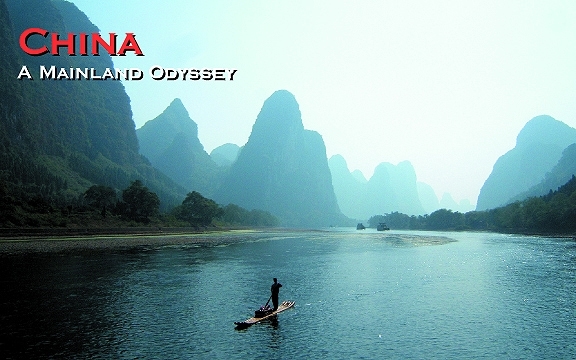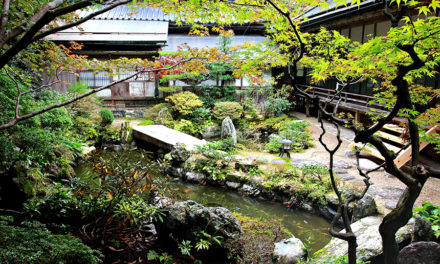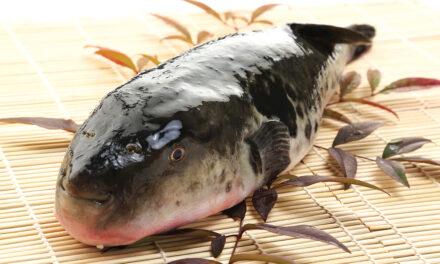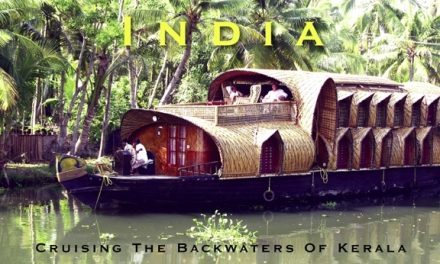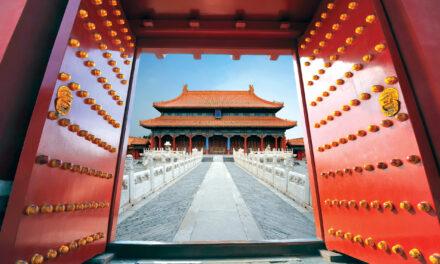China
A Mainland Odyssey
Published in the Winter 2007-08 Issue of Canadian World Traveller
Text & Photos by Michael Morcos
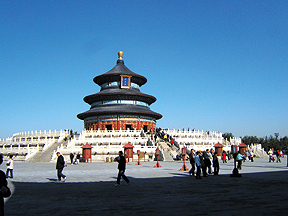
Sometimes words and images cannot quite describe an experience. This is the case with my recent trip to China. I had visited Hong Kong and Taiwan but neither of these Chinese destinations could match the mainland.
My ten-day trip would take me to the southern provinces of Yunnan and Guangxi and then north to Beijing. As I would soon find out, China’s southern provinces and the country’s dynamic capital could not be farther away from each other, either in terms of distance or culture.
Yunnan Province
Looking at a map, I discovered that Yunnan Province is very close to Indochina. This southern Chinese province shares its borders with Vietnam, Laos, Burma and Tibet. Of China’s 56 ethnic groups, 25 of them are found in Yunnan. Fifteen of these ethic groups also live in neighbouring countries. The population of this relatively small province is more than that of all of Canada, as is the case with most of China’s 23 provinces.
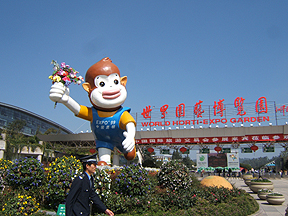 Kunming Arrival
Kunming Arrival
Kunming, the capital city of Yunnan Province, was my first destination and getting there was a trip on its own. The journey from my home base in Montreal to my hotel room in Kunming involved four airports, three planes and a total travelling time of some 32 hours (a personal record)!
Exhausted and maybe a bit delirious from having had just half a night of sleep in two days, I didn’t miss a beat as I found myself exploring the Kunming Expo Garden, one of the city’s most visited sites.
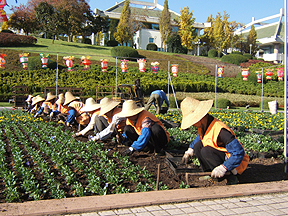 The garden exhibition ended in 1999, but the site was kept open with the help of armies of gardeners. It now serves as a permanent city attraction.
The garden exhibition ended in 1999, but the site was kept open with the help of armies of gardeners. It now serves as a permanent city attraction.
Its China Hall is composed of 34 sections representing the country’s provinces and regions.
I only managed to visit a few of the pavilions but found each of them to be unique in their architecture and lushly landscaped gardens.
Dance and Musical Performance
In the newly built Yunnan Grand Theatre, the audience sat quietly in the darkened hall. This was the perfect setting for falling asleep. With my jet-lagged body, I could easily have slipped into dreamland but found myself sitting on the edge of my seat, totally enthralled by the fantastic musical and dance performance that lasted for 90 uninterrupted minutes.
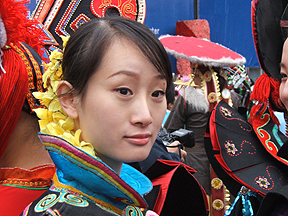 As scene after scene unfolded, I found myself thrilled by the high energy of the performers who combined breathtaking gymnastics with traditional Chinese theatre and modern dance.
As scene after scene unfolded, I found myself thrilled by the high energy of the performers who combined breathtaking gymnastics with traditional Chinese theatre and modern dance.
The Chinese instrumental music and the songs in Mandarin were wonderfully complemented by the elaborate costumes and the lavish stage decor. The show depicting the history of Yunnan through the ages was a perfect introduction to Mainland China.
Revitalizing Massages
During the following days, I couldn’t resist getting massages. The first one was a complete foot massage followed by a two-hour-long full-body massage. This would prove to be a dangerous habit as I sought out many more revitalizing massages throughout the trip. The price was right, as a foot massage that included a hot cup of tea was only $5, while a full body massage was never more then $12.
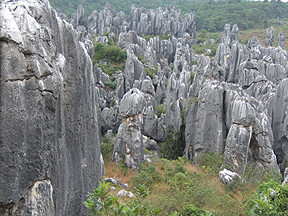
Stone Forest
The Stone Forest situated 126 kilometres southeast of Kunming, covers more than three hundred square kilometres. Being one of three World Heritage Sites found in Yunnan Province, it was very crowded with both foreigners and Chinese tourists on the day of our visit.
As the name implies, the landscape was covered with stones. Some were very small while others the size of small hills.
Interestingly, the Chinese seem readily able to identify figures of all sorts of animals as well as people in the stones, however it took me a while to decipher the hidden images.
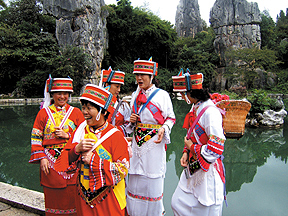
At one of the more popular areas, we found members of the Yi ethnic group dressed in their traditional costumes.
Tourists could rent the costumes, dress up in them and have their pictures taken with the famous rock formations as a backdrop.
An Art Factory
One next stop was an art factory in a small town where smiling and ever patience artisans produced fine handmade carpets and pinpoint needle masterpieces.
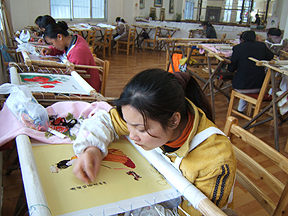 The workers’ quarters were within sight of the extensive showroom. Magnificent examples of their work that took weeks to produce were on sale at remarkably affordable prices.
The workers’ quarters were within sight of the extensive showroom. Magnificent examples of their work that took weeks to produce were on sale at remarkably affordable prices.
While speaking with the owner, he mentioned that this factory has been in existence for many decades but was discouraged during the era of the Cultural Revolution.
It is only in the past twenty years that production was resumed. Sadly, these are dying art forms, as it is becoming more and more difficult to find workers with the required skills.
Shoppers Paradise
Shopping for locally made products was easy at the “Colourful Yunnan Market”. Busloads of people would stop at this huge market where they would find that the market was comprised of several buildings that encircle a park and manmade pond.
The stalls in one building were filled with precious jade articles, while those of another building offered locally grown teas, herbs and medicinal roots. In yet other buildings exquisite handmade arts and crafts were displayed. This was a perfect place to buy souvenirs and gifts, all produced right there in Yunnan.
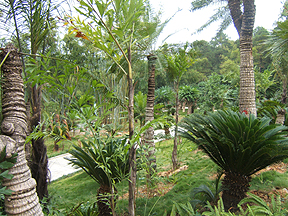
Guangxi Province
Guangxi’s capitol of Nanning boasts that it is “China’s Green City”. I found this to be true, as almost every part of the city was covered in trees, bushes and flowers. Even the highway and tollbooth dividers where filled with plants.
Cows in the Roadway
On a scheduled rest stop, I noticed water buffalos wandering about on the two-lane highway. It intrigued me enough to ask our guide about this seemingly unusual occurrence.
I was told that once the buffalos’ day’s work was done they were set free to wander around. They would go to their favourite places, whether in nearby hills or rivers, to leisurely spend the evening. Without fail, they would find their way home on the following day to begin work again. Apparently water buffalos are well taken care of by their masters who treat them like family members.
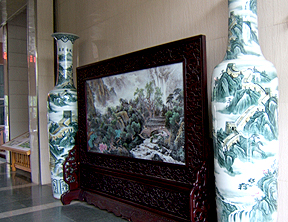 Guangxi Museum
Guangxi Museum
The exhibits at the Guangxi Museum highlight the cultures of the province’s ethnic groups. Like Yunnan Province, Guangxi has many ethnic groups and this museum allows visitors to explore their customs, ancient artefacts and histories.
The largest and most impressive artefacts were the bronze drums of the different ethnic groups, some measuring up to 1.5 metres in height and width.
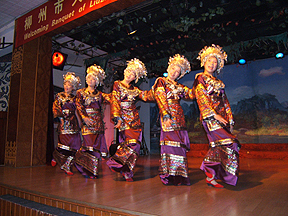
Poolside Supper Show
We were treated to a supper show at the Big Dragon Dalong pool. As the great food kept on coming, a song and dance show was expertly preformed by the Mio, Dong and Yao ethnic groups, dressed in their traditional colourful costumes.
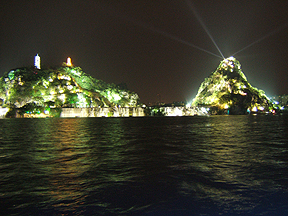 Night View of Liujiang River
Night View of Liujiang River
Viewing the biggest artificial waterfall in China at night was truly a spectacular sight. Located on the Liujiang River, the Pan long Waterfall measures more than 220 metres in height and 13 metres across.
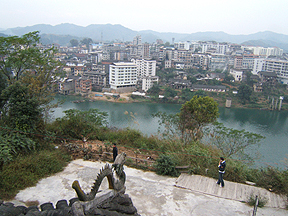 Rang’an
Rang’an
The bus trip to Rang’an was like a trip back in time as I witnessed street after street full of bicycles, mopeds and motorized bicycles with small cabins attached to the back that can hold as many as three people.
Our guide told me that this area hadn’t been modernized so the town was still free of industrial development. This was an interesting contrast to the big cities of Kunming and Nanning and I enjoyed the short time we were there.
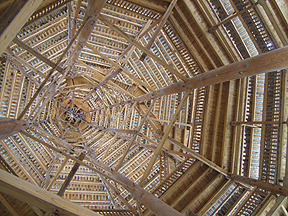
A short distance from town, we visited the Sanjiang Wooden Drum Tower. The impressive newly built all-wood pagoda tower was the tallest in Southern China.
Pagodas were used for many reasons but mainly as watchtowers to spy approaching enemies and to call the local people to a town meeting. Unfortunately, most pagodas are susceptible to lighting and fire, so they often have to be rebuilt.
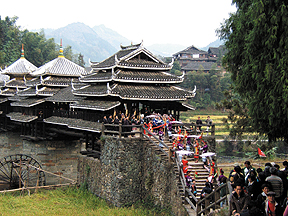 A Fairytale Village
A Fairytale Village
Our hosts, the Dong people in the village of Chengyang, greeted us with rice wine. They waited for us at the entrance to the beautiful Yongji (wind and rain) covered bridge dressed in their traditional garb.
Their welcome began with a song as they offered us the cups of rice wine. Drinking the heady portion was not an option as it was the only way to be permitted to cross over the bridge that led to the village.
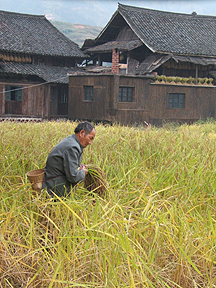
The village was out of a fairytale book with people working the rice fields, watermills on the river banks, children playing with their dogs and farm animals everywhere, while the elderly residents, dressed in dark blue clothing, sat in front of there homes and smiled at the visitors.
Noticeably absent were cars, electrical and telephone wires and other intrusive signs of modern life. A visit to this village takes you at least a couple of centuries back in time.
A Festival to Remember
The evening was no less exciting as we climbed to the town’s meeting place on top of the hill for what promised to be a great festival. The whole village would be in attendance. This included as many as a hundred of its families bringing their homemade dishes.
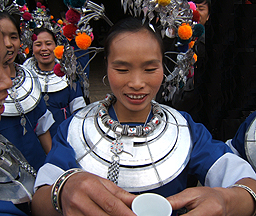
The festival began with dancers and singers who filled the night air with their tradition folk songs and chants. Next came the meal.
Within no time the square was transformed into a large outdoor café. Wooden tables and benches were placed cafeteria style and the guests were invited to sit with the locals.
Conversations were limited due to the language barrier but the big smiles confirmed that we were all in a state of bliss.
One by one, the guests were approached by groups of singers armed with rice wine. They would come up to you, sing a song then pour a huge cup of rice wine, which you had to drink in one shot. Needless to say we were more than content but sadly had to eventually bid our affable hosts goodnight.
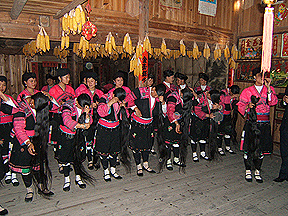 Longsheng Charm
Longsheng Charm
The following day would prove to be just as exciting as we had lunch with the Zhuang people and then visited the Yao people’s village and their fabled Longji terraced rice paddies.
Life in the Yao village was charmingly simple. Its ever-smiling people performed a fascinating show for us. Yao women are known for their very long hair, which they wrap around their heads.
During the one-hour show, some of the elderly women participating in the performance let their hair down. Amazingly their jet-black hair reached down below their knees.
In the second part of the show, male members of the audience were invited to go through a mock wedding ceremony with a Yao young lady. This hilarious bit of theatre demonstrated the light-hearted nature of these welcoming people.
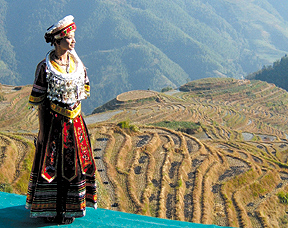 The Longji Terraces
The Longji Terraces
On the way to view the Longji terraced rice fields, we steeled ourselves as our bus snaked up the steep mountain.
From the point where the bus let us off, there was a 45-minute walk to have the best view of the amazing fields. Hot and sweating, I made it to the top for the spectacular vista.
Enjoying the view, I lost track of time and had to run back down. On a couple of occasions I had to back up off the narrow cliff path to let a mule and then two men taking someone down in a rickshaw go pass.
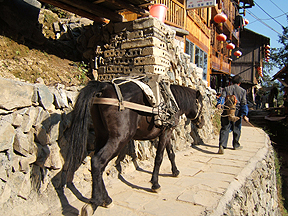 Even though I was pressed for time, I had to stop to get a picture of a young lady dressed in a beautiful Yao costume. Everything seamed perfect at that moment.
Even though I was pressed for time, I had to stop to get a picture of a young lady dressed in a beautiful Yao costume. Everything seamed perfect at that moment.
The sun was brightly shining, the backdrop of the rice fields in the mountain were dramatically lit and the smiling young lady was ever so patient as I snapped up a dozen or so pictures that would remind me of this very special part of China.
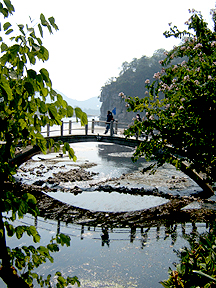 Riverside Guilin
Riverside Guilin
The City of Guilin, situated on the Li River in the northern part of the province, was our next stop. We planned to spend just enough time to see the most outstanding points of interest in this popular tourist destination before heading up the Lijiang River, a trip that would take us past some of the most breathtaking land formations in all of China.
We visited Seven Star Park, Reed Flute Cave and Elephant Trunk Hill Park but the Guilin’s most amazing attraction was a nighttime boat ride through the heart of the city.
The small boat had an interior cabin but I chose to stay on the outdoor deck to get an unobstructed view during the one-hour cruise. This part of Li River and its canals were specifically developed for tourists but nevertheless the boat ride was a great way to get yet another taste of China.
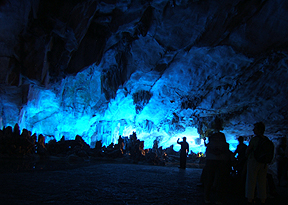 The riverbanks were romantically illuminated. We cruised past water fountains, waterfalls, riverside stages where dancers performed traditional Chinese theatre, other stages with musicians playing traditional instruments and under bridges that resembled famous bridges, only constructed on a miniature scale.
The riverbanks were romantically illuminated. We cruised past water fountains, waterfalls, riverside stages where dancers performed traditional Chinese theatre, other stages with musicians playing traditional instruments and under bridges that resembled famous bridges, only constructed on a miniature scale.
Amazingly, the boat slowed down for us to see a fisherman on a bamboo raft fishing by the light of a lantern. Instead of a rod or net, he was using tamed cormorants birds that wore collars around their necks so that they wouldn’t swallow their catch. The fisherman would then snatch the fish from them, depriving the birds of their well-earned meal.
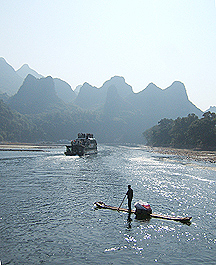
Lijiang River Boat Ride
The scenery on our boat ride along the Lijiang River was right out of travel brochures and classical Chinese paintings.
The beautiful sunny day added contrast to the jagged edges of the rock formations that sprung up out of the still clear waters of the river.
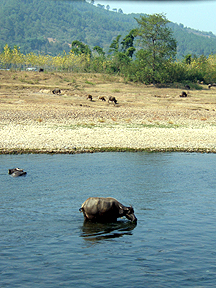
I stood at the front of the boat to get the best view of the quintessential China we have all envisioned.
The sight of local fisherman on their bamboo rafts, water buffalos grazing at the riverbanks, farmers tending their rice paddies and kids swimming in the river and waving at us while greeting us with their big smiles, all made this a truly unforgettable experience.
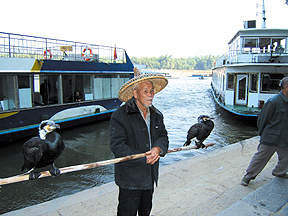
Yangshuo City
Our boat trip ended at the town of Yangshuo where we had free time to wander through the market.
This was a shopper’s haven and I made good use of our time by visiting the many merchants who where only too happy to haggle over the prices of their products.
In the end, I found myself with a knapsack full of goods without making even a dent in my wallet. The only problem I had was how to bring all my purchases home!
That evening, we were treated to the amazingly choreographed “Impressions on Liu Sanjie”, a nightly spectacle that takes place outdoors on a semi-enclosed lagoon. This would prove to be a great climax to our visit to Southern China, as the one-hour show left me in awe.
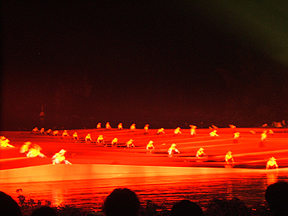 This is the world’s largest natural theatre, which utilizes the perfectly reflective still waters of the Li River as its stage and twelve surrounding hills as its backdrop. The 600 performers are all locals hailing from Li River districts.
This is the world’s largest natural theatre, which utilizes the perfectly reflective still waters of the Li River as its stage and twelve surrounding hills as its backdrop. The 600 performers are all locals hailing from Li River districts.
Viewing scene after scene, I felt like a little kid at the circus. From the first scene, when the lights dimmed and ladies’ soft voices broke the silence of the night to the seventh and final scene, in which more than a hundred illuminated performers seemed to walk on the water, this show confirmed for me that China was indeed a great country.
Beijing
Beijing was the last capital city on our schedule, but unlike Kunming and Nanning that are provincial capitals, Beijing is the capital city of all of the Middle Kingdom.
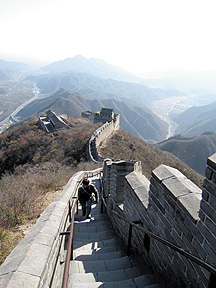 I was always intrigued by places with names like The Forbidden City, The Temple of Heaven, Tian’anmen Square and The Great Wall. I would finally visit all these fabled places during my two-day stay in Beijing.
I was always intrigued by places with names like The Forbidden City, The Temple of Heaven, Tian’anmen Square and The Great Wall. I would finally visit all these fabled places during my two-day stay in Beijing.
The Great Wall of China
Chairman Mao was quoted as saying “If a man goes to Beijing he must go to the wall, if he goes to the wall he must go up to the top, if not, he is not a man.” Being in Beijing and having heard that famous quote, I knew there was only one thing to do. Go to the top of the Great Wall!
Just minutes from Beijing, I found myself smiling as I stood on one of mankind’s greatest achievements. Before me and as far as the eye could see was one of the most impressive sites I had ever seen. But looking was not enough I had to get to top of it.
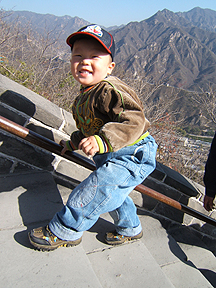
The traffic jam of people made the very steep climb along the wall quite slow at first. It wasn’t until the second watchtower that most of the other visitors turned back, giving me a clear passage ahead. At this point along the way to the top, I only passed the odd person catching his breath.
Although it was cool and windy I was hot and sweaty and the 45-minute climb brought me to a fantastic view of the wall as it hugged the rugged terrain of the surrounding mountains.
On one occasion, I had the pleasure of meeting the youngest climber of that day. He was barely old enough to walk, yet he was all smiles, as he eagerly and bravely negotiated his next step. It seemed that there were at least two newcomers to the wall that day!
The 2008 Olympic Games
Considered a lucky number in Chinese culture, it was not surprising that the Summer Olympics Games’ opening ceremonies are scheduled for the 8th day of August (the eight month) of 2008 at roughly 8:00 p.m. local time.
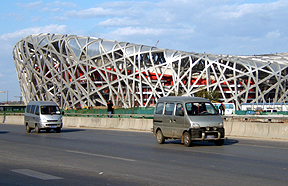 From a distance, I was able to view the newly constructed Olympic installations. The Beijing National Stadium, also known as the “Bird’s Nest” will host the main track and field competitions while just to the left of it is the Beijing National Aquatics Centre also known as the “Water Cube”.
From a distance, I was able to view the newly constructed Olympic installations. The Beijing National Stadium, also known as the “Bird’s Nest” will host the main track and field competitions while just to the left of it is the Beijing National Aquatics Centre also known as the “Water Cube”.
Both buildings are very unique in their conception and design and if the Games live up to these innovative structures, then they will indeed turn out to be the most exciting Summer Olympics Games ever held.
The Silk Market
Nothing could have prepared me for my visit to the Silk Market. I first thought that the market was outdoors and sold silk. Instead, I found that it was indoors in a six-floor department style building on Beijing’s busy main street, Chiang’an.
The best way to describe this place is to compare it to a Dollar Store with everything else a person could possibly want at bargain prices. The merchants were all independent and each had a 10′ by 10′ space that was stacked with merchandise. Each floor had a specific category of items. The ground floor was for knock-off clothing that looked close to the real thing such as Polo shirts and other high-end apparel. The basement had shoes, luggage and leather ware.
Here, haggling is an art form and the smiling but quite aggressive merchants would not let you leave without you buying something, even if you all you did was ask to the price of an item. I found myself lost for hours until the late closing. In the end, I was weighed down with purchases that I knew would be difficult to bring home. But that was a problem for another day. At that moment I felt like a thief on the run.
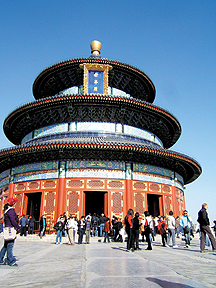
Temple of Heaven
Beijing’s Temple of Heaven is one of the largest historic sites in China. It is very impressive and takes quite a bit of time to thoroughly visit.
The most important building is the “Hall of Prayer for Good Harvests”, but the most popular attraction is the “Marble Platform” and particularly the “Round Altar” where most visitors have their pictures taken.
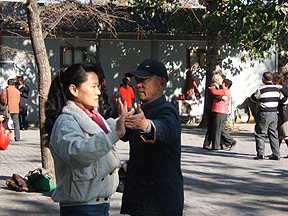
I was most impressed at how the locals visited this site to socialise. Some would dance with their partners. Others would exercise in groups.
Many played cards, dominos, Chinese chess or musical instruments. This confirmed for me all that I had seen throughout my trip. The Chinese are indeed a very social society!
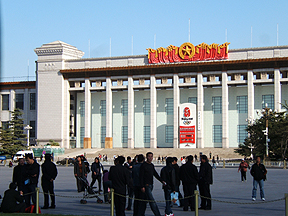
Tian’anmen Square
Tian’anmen Square, one of the most important and the biggest square in the world, seemed to go on forever.
It would take at least a day to visit and learn about all of its many important monuments, buildings and museums.
These include Mao’s mausoleum, where chairman Mao’s embalmed body rests; the China National Museum; the Great Hall of the People, seat of the Chinese legislature; and Tian’anmen, which is one of the gates of the Forbidden City, where Mao proclaimed the founding of the People’s Republic of China in 1949.
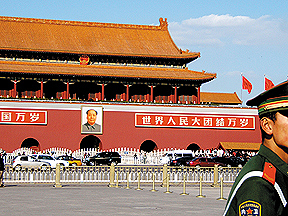 While visiting the square, I learnt about the significance of the design of the Chinese flag. My guide explained that the big star represented the leaders of the country while the surrounded four smaller stars each represented the student/teacher, the businessman, the farmer and the worker.
While visiting the square, I learnt about the significance of the design of the Chinese flag. My guide explained that the big star represented the leaders of the country while the surrounded four smaller stars each represented the student/teacher, the businessman, the farmer and the worker.
The red colour of the flag stood for the blood lost in fighting for the Republic and the yellow colour of the stars represented the Chinese people.
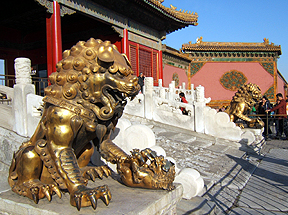
Forbidden City
The Forbidden City is no longer forbidden. Today, this formerly exclusive enclave is open to both Chinese and foreign visitors.
On the day of my visit, I had to make my way through masses of tourists.
This complex, recognised for its magnificent architectural design, sits in the middle of Beijing. It was completed in 1420 and remained the domain of the Imperial Court until 1920. Happily, it was opened to the public in 1949.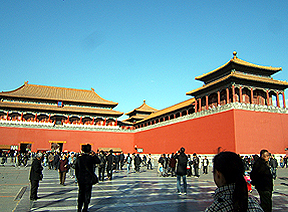
My guide illuminated the many interesting aspects of the large complex including the those of the Hall of Supreme Harmony, the marble Carriageway, the Meridian Gates, the huge bronze Chinese Lions and the Golden Water with the five marble bridges that cross it.
But the most persisting thoughts that that I had while there were of the scenes from the Hollywood movie “The Last Emperor”. I kept imagining the era when the child emperor was greeted by his army and dignitaries in the grand ceremony held in this very Forbidden City.
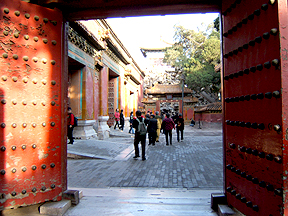
Lasting Memories
As I sat on the plane heading for home, I knew that I had only touched the surface of all there is to see and do in China.
My thoughts were of how I had originally envisioned China and how my perception of the country had changed after my ten-day visit.
As a child, I was told that if I dug a hole straight down in my backyard I would get to China. I finally got there and now I hold the Middle Kingdom close to my heart.
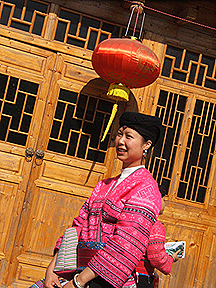
For More Info:
China National Tourist Office
480 University Ave, Suite 806
Toronto, ON M5G 1V2
Tel.: 416-599-6636
Email: cnto@tourismchina-ca.com
Website: www.tourismchina-ca.com

